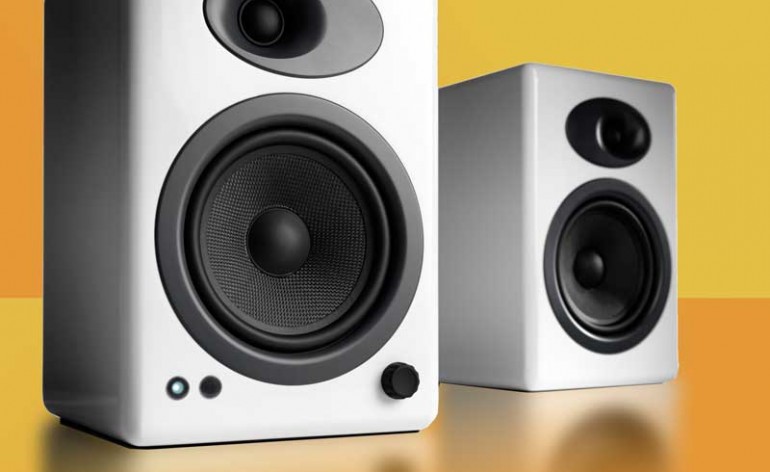Desktop Audio Computer Speakers—Getting Good Sound
I have some really great speakers that I am half-tempted to put next to my desk. They’re a pair of Def Tech’s and they are the biggest “bookshelf” speaker I think I’ve ever seen (yes, those quotes are there for a reason). But when you want to get good pair of desktop audio speakers you can’t just slap up the nearest discount speakers and hope for the best. There are some basic guidelines that will help ensure you don’t get funny stares and vacant nods when people wonder how on earth you thought duct-taping speakers to the top of your 24″ monitor was a great idea…
Follow these steps and I think you’ll at least be off to a good start in getting good sound with a desktop audio system.
First and Foremost—Choose Your Speakers Wisely
Obviously, if you’ve already got speakers picked out, then go ahead and jump to the next topic—but you may want to hang around just to hear what I think about selection. These probably won’t be the last speakers you buy, and they may give you some advantage the next time you go shopping for you or a friend.
The first thing to consider when selecting speakers for a desktop application (aside from budget) is size. There is a reason you don’t want to put gargantuan speakers on your desk—even if they manage to fit. Larger speakers in close proximity to your face simply won’t image properly. That means that instead of the singer coming from the middle, you’ll hear him or her from either the left or right speaker, depending on which way you happen to lean or turn your head. That’s no good. There is a way to make larger speakers work, however.
Use Speaker Stands When Needed
If you happen to have larger speakers handy, not all is lost. You can mount them on speaker stands, spread wide enough to get a nice stereo image, and set back far enough that the sound has a chance to coalesce properly at your seat. When you use speaker stands you open up the possibilities to true bookshelf speakers and greater dynamic range as well as better frequency response. If you can pull this off, it’s perfectly alright—just don’t force it into a situation where it doesn’t make sense—even if you have some extra speakers lying around. If your desk is pushed up against a wall, you’ll never get the distance you need for proper imaging. It’s back to smaller speakers designed for nearfield listening.
Positioning Smaller Multimedia or Desktop Speakers
I was tempted to run with larger bookshelf speakers in my office, but I’m up against a wall and it’s a multipurpose room. No, for me, desktop speakers are the ticket. These are smaller speakers that can sit easily on the surface of the desk and produce an adequate soundstage at close proximity. A separate subwoofer can be located on the floor, but more on that later.
With multimedia speakers, you really want to get them pointed at you. I have yet to run into a pair of smaller desktop or multimedia speakers that sounded better when toed outward. They simply need to be pointed at you in order to properly recreate the stereo image of the recording. One thing to keep in mind, however, is that you get to sit right in the sweet spot. Just you. And that’s a HUGE advantage. In home theater, you want to get good sound in a variety of seats (well, that is—if you’re not entirely selfish). At a desk, it’s all about getting the best possible sound in your chair. That’s good news because it means you can make micro-adjustments to how your speakers are positioned and not have to worry about blowing up the sound in other locations.
So adjust away. Experiment with tilting the speakers at you, or perhaps pointing them slightly downward if the high frequency response seems a bit harsh. Driving the sound slightly off-axis will help tame these highs. Most desktop speakers I’ve reviewed tend to have a reasonably wide dispersion. This means that you can keep a pretty good lock on the sound quality even if you reach over to adjust a monitor or pick up a piece of paper.
Is That a Subwoofer Under Your Desk or Are You Happy to See Me?
Adding a subwoofer to a multimedia speaker system is just plain good sense. It will absolutely sweeten the sound and make for a very impressive experience. Plus, like the desktop speakers, you can adjust the sub (i.e. move it around) so that it sounds good in your seat—who cares about the rest of the room?**
**There is one caveat to this statement. One time I had tweaked the subwoofer so that it sounded and felt very nice and powerful at my desk. Little did I know that I was sitting in a “dip” or low area for bass. Several feet away the bass was registering about 6 times louder and driving one of my coworkers insane. The lesson here? While you are primarily concerned with the sound at your desk, it isn’t a bad idea to get up and walk around while the music is playing in order to “check your work.”
A lot of desktop audio speaker systems will include a subwoofer. This is fine, and often these subs are perfect—particularly if you can’t play your audio all that loudly. Sometimes, however, when you have the freedom to roll your own components, you want something with a bit more oomph.
Using an External Audio DAC
And this is how you get more oomph. An external DAC is like an external sound card. It will let you connect to your computer via USB and then have analogue connectivity for powered speakers or an amplifier. The advantage here is that often you can nab an extra set of analogue outputs (either directly, or by using a Y-cable) which can then be connected to most traditional subwoofers. And if you can do that, then you are really stepping up your desktop audio system to something very impressive indeed. The other advantage to using an external DAC is that it often will allow you to automatically defeat the speakers when plugging in headphones to the headphone jack. This is extremely convenient and saves you a lot of hassle over having select your audio output or manually mute the speakers during a call.
Some DACs are just that—conversion devices, while others may include an amplifier. You don’t need an amp if you’re using active monitors or powered speakers, but you do if your speakers are passive. Keep this in mind as you probably don’t want to pile boxes and boxes on top of each other just to playback some music at the desk. I try to minimize the amount of hardware I need at any given time.
Conclusion
While we can think of just about an endless list of things to do to mess with a traditional 5.1 home theater system, adjusting your desktop or computer speakers is somewhat less involved. Play with position, play with the angle and work with your low frequency options. Getting those areas right will land you some pretty excellent sound that will make your desktop sound like a small mixing or mastering workstation…at least that’s a goal you can shoot for.
Like these articles? Give us a shout-out on our Facebook page and Like us to make sure we can continue to bring you more helpful tips and tricks.







Pingback: How to Use Facebook fTalk -